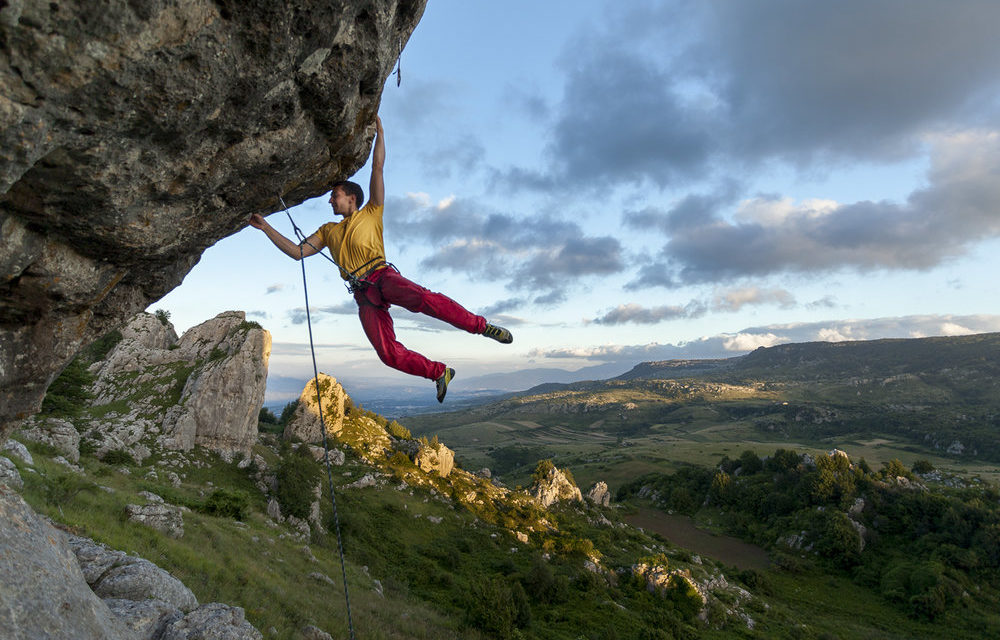Francesco Guerra is an Italian adventure photographer with a passion for travel, dramatic landscapes, and putting himself in just a touch of danger to capture the raw and real moments of outdoor adventure. Far from being just a climbing photographer, Francesco’s extensive portfolio includes skiing, mountaineering, alpinism, high lining, backpacking, landscapes, and even some home interior photography.
Influenced by photographers like Sebastiao Salgado, Chris Burkard, Jimmy Chin, and Alex Strohl, Francesco’s photos portray a unique vastness that inspires me to seek out the world’s wildest places.
I caught up with Francesco via Skype in his ample free time since incurring a knee injury while skiing. In this interview, we cover how Francesco evolved from a landscape photographer to an adventure photographer and how he came to shoot photos from big outdoor industry names like La Sportiva and Garmont. Despite these impressive partnerships, Francesco’s views on his work are refreshingly humble and he offers some poignant views for professional and passion project photographers alike.
SNAPSHOT
Age: 28
Hometown: Naples, Italy
Years climbing: On and off since 2012
Years taking photos: Too many to count. He graduated with a BA in photography and cinema in 2015
Camera choice: Canon EOS 5D Mark IV
Preferred style of climbing: Surely not slab
Upcoming plans: To move north to the Alps to pursue mountaineering and alpinism photography work
Website: https://www.francescoguerraphoto.com/
Instagram: @francescoguerraphoto
How many years have you been climbing?
I started first in 2012, but then I had an accident doing skydiving (he says very casually) which stopped me for a year. Then I didn’t get back into climbing until 2017.
Were you a photographer or climber first?
I started with photography and I have a bachelor’s degree in photography and cinema from the Academy of Fine Arts in Naples. Before adventure photography, there was landscape photography without any human pictures. I was bothered by the human figures in pictures. I was like, “Oh, there’s a human there, I need to cancel, to erase that human.” Then I got back into climbing and started to think, “Hey, I could actually take pictures while climbing.” It was a slow process. Here in Naples, we have just one little climbing gym and a little community of climbers so the possibility to go outside and shoot are really narrowed down. Nearby you have nothing but the city, the sea, and good food… but not climbing.
Adventure photography can be a tough field to break into. Given that and the difficulty of your location, how did you transition into photography as a profession?
For two years, I just did adventure pictures for passion, while working remotely as a wedding video editor and photographer. Then I met this semi-professional climber from a nearby region named Pietro Radassao. He’s actually sponsored by La Sportiva and we did many different shootings and two videos. Eventually, I ended up selling many pictures of him to La Sportiva.
That was the first [big brand partnership], but then I got contacted by Garmont…and we ended up doing a big shooting for their social media, web advertising and printed ads. We created over 200 photos of different footwear for via ferrata, mountaineering, hiking, and travel.
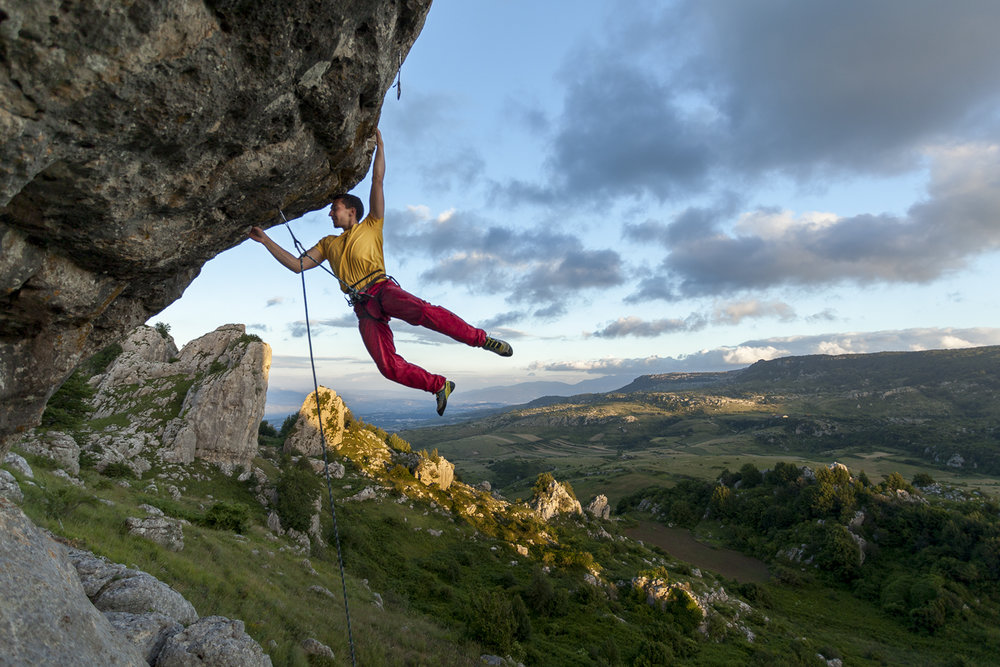
Pietro Radassao by Francesco Guerra
What type of camera do you use?
I use a DSLR, a Canon EOS 5D Mark IV. My favorite lenses are the 17-40mm, which is a wide to medium zoom lens, and 70-200 mm. 90% of the shootings I do with the 17-40 mm, because my style is staying in the action and not just being an observer, or staying in a safe place with my zoom lens. I want to stay in the action with the athletes, and with a wide-angle to actually show the place they are playing in.
Other than being in action, is there anything you would describe as a key characteristic of your work?
I put myself in danger more than the athletes. In one shot, you can see this climber standing on a rock pinnacle. To do that picture, I climbed free solo (without any rope) on a 6-7 meter rock and just sat there. I wasn’t so stable but I didn’t care at the moment. I was just there to take the picture, and the climber didn’t even know I was there. (Note: This photo was later featured on National Geographic’s website). When I try things myself, I get the right amount of anxiety. When I do photography, all the fear just goes away and I could free solo anything to do the pictures. But I do things I know I can do. I would never free solo Freerider in Yosemite to capture anyone else.
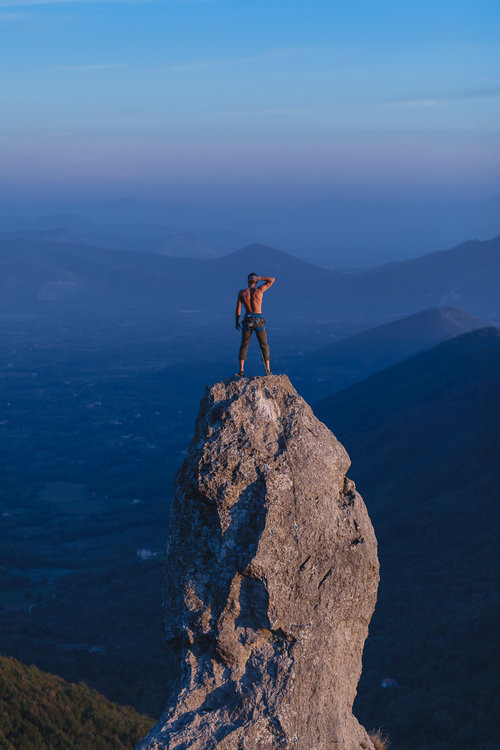
Photographer: Francesco Guerra
What has been the most rewarding experience you’ve had shooting?
It’s the people you get to know, and the experiences you have. [He draws my attention to one of his slacklining images.] That day I met two guys from Sicily who do a lot of high line. We joked a lot and stayed in contact. Later I went to Sicily to shoot them and we started a new kind of collaboration. It’s an ongoing project so photos aren’t yet available.
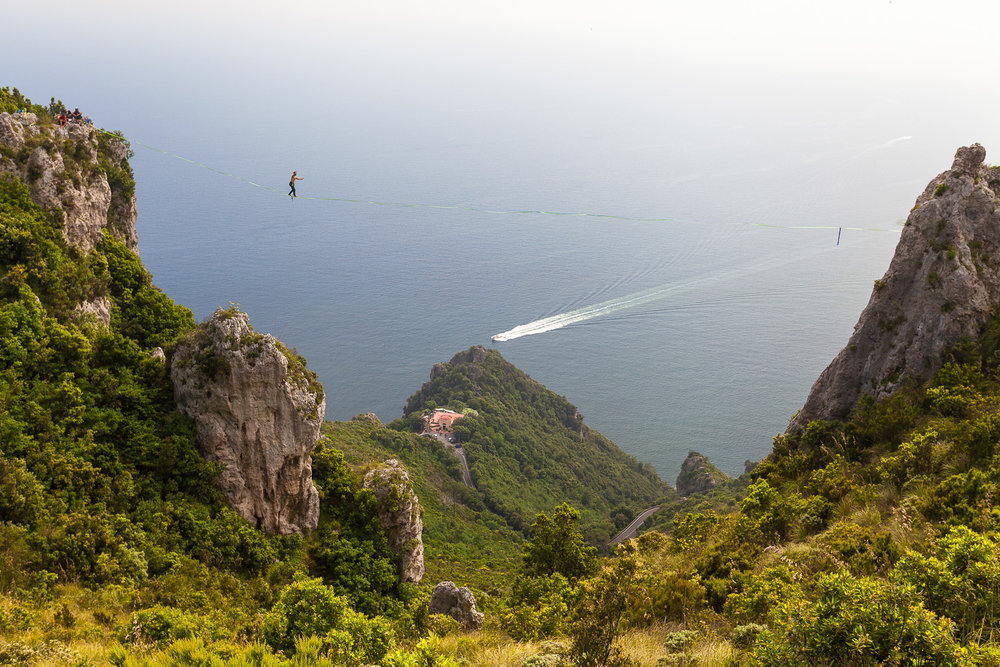
Photographer: Francesco Guerra
You also have a series of Analog Adventures on your website. I imagine shooting adventure photography is much more challenging on film. Tell me about that process and what inspired you to try it?
Funny thing, because it was just out of nowhere that started this series that I hope will transform into a book. I found this old 1960s Canon FTQL for $20 on the internet and soon afterwards found a 28mm Canon analog lens for $20. On my birthday, I had the opportunity to shoot the first of the series of new mountaineering routes opening in my backyard crag. It was quite challenging using just one roll of film to tell a story. With digital nowadays, if you know how to use the camera and you know how to process an image, it’s simple to make a good final image. With analog, it’s not really possible to go back and adjust. You must try to prevent even one frame becoming garbage because you only have 36. In fact the first frame of this series I accidentally shot with the lens cap on so it was all black.
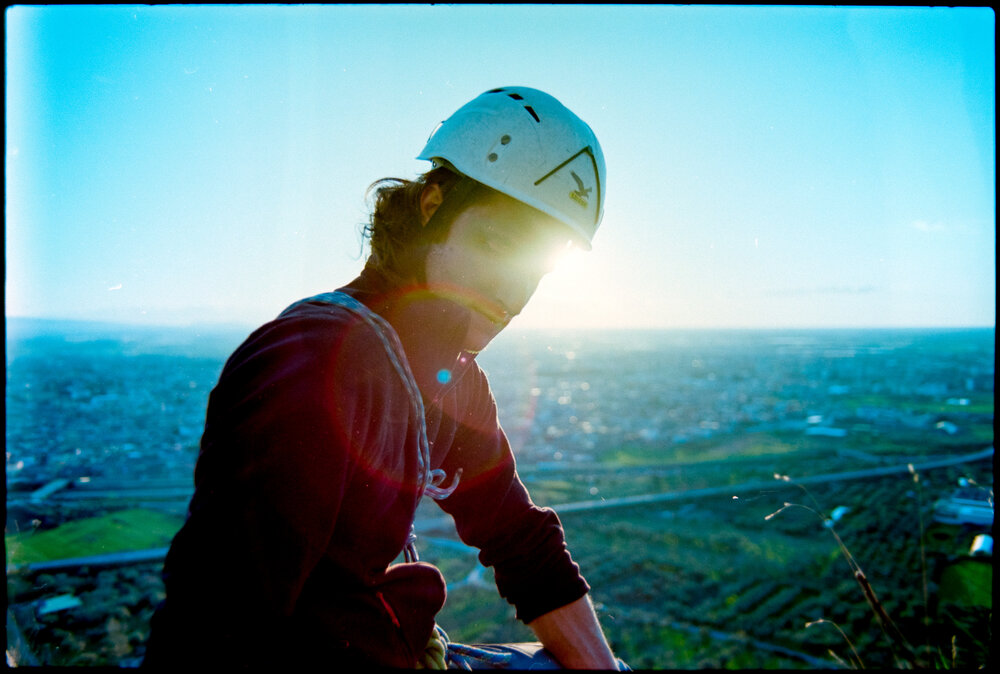
Photographer: Francesco Guerra
If you weren’t climbing and shooting photos, what would you be doing?
I play the guitar actually. Not even outdoor-related! I write, and I read a lot of books about the outside: mountaineering books, climbing books, travel books.
Do you have a favorite book?
That’s a mean question, but if I have to choose one, I’ll go with my favorite teenage-age book. It’s The Lord of the Rings. That and The Silmarillion are hands down the best because of all the imaginary landscapes. All the fascination I got to start landscape photography came from there and from the films.
What is your favorite destination for climbing? For photography?
The best destination I’ve been is: one I haven’t been yet. Every destination I go to is unique in some way. If I should pick one for photography, Scotland because of its wild and unspoiled landscapes. When I went there in 2017, we were on the Isle of Skye and it was just so wild. That’s just the landscape photographer in me talking. For climbing, I would say the Amalfi coast is a favorite. It’s one hour from my home and it has so much potential yet to be discovered and so many different types of rocks.
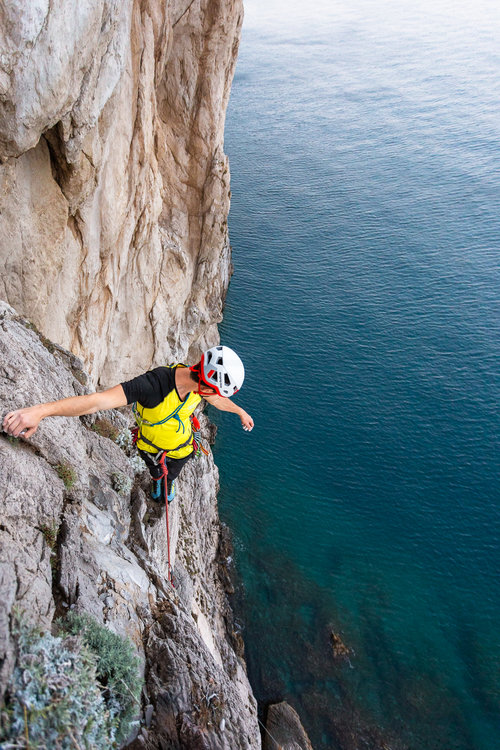
Amalfi Coast by Francesco Guerra

Amalfi Coast by Francesco Guerra
What about your job do you love most?
The experience. Every time is different. If you shoot climbing, for instance, you get on the rope, and the moves may be the same but the feeling is always different. You always learn something about yourself.
What’s the most challenging part of your job?
Most of the time it’s not fun in the way you say, “Let’s have fun!” Most of the time, you’re carrying your weight in your bag. With the hardware, rope, and photography equipment you feel like a sherpa. It’s not fun while you’re on a static rope and your life is linked to that rope. You’re not having fun, but the passion for what you are doing overcomes that pain and anxiety that comes with going on that darn rope.
What advice do you have for hopeful adventure photographers?
This is what I would like to give to myself some years ago: continue shooting and don’t get phoned in with your pictures. If you do, you could get stuck in that style. Never stop learning because everything could be useful one day, in photography as in life. Let’s say, you’ve never climbed; Take a course, do your homework, go to a crag and know people who can help. Learn, learn, learn, and make connections, because, at the end of the day, you cannot take pictures of yourself (at least not all the time). Make connections and good friends because they will help you out in some way.
What do you ultimately try to communicate with your photography?
It’s not just a sense of action or the athletic movements, but also a sense of freedom. That’s what I think I crave most in my life, Freedom. Being free. That’s why I chose a freelance photography job. I don’t want to sit at a desk or work for a boss. I want to be the boss myself, and so I try to put this sense of freedom in my pictures, always.
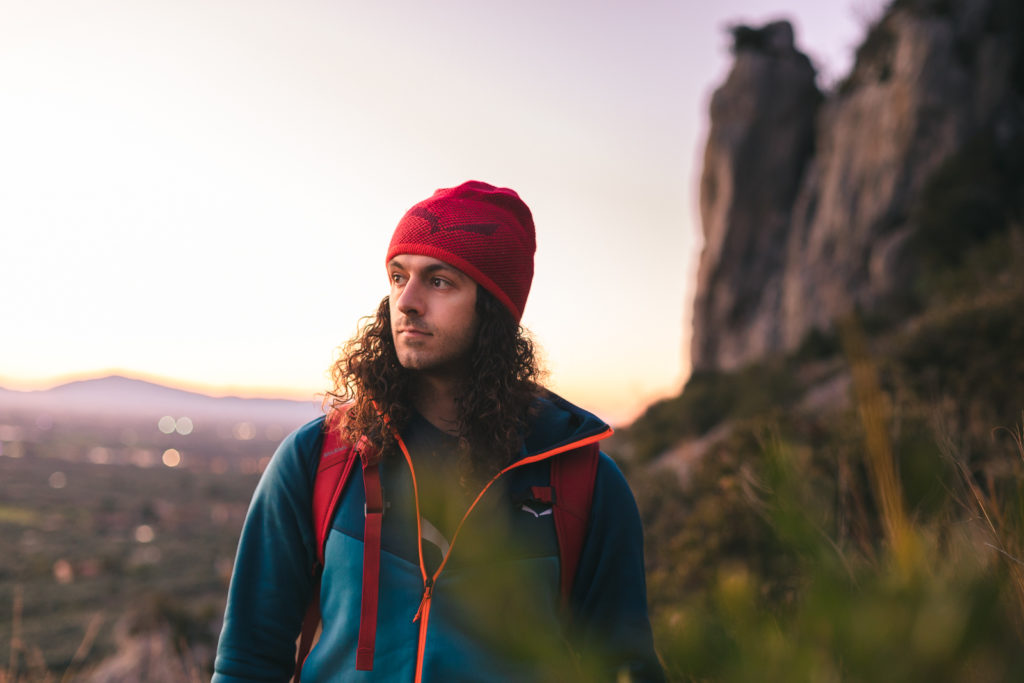
Credit: Francesco Guerra
Francesco and I wrapped up our interview by expressing how he hoped he was able to convey meaning and freedom with his photos, but wasn’t so sure: “I am the worst critic of myself, because what I want in the end is to improve always. I think if you stop improving, you are done. So now I’m trying to improve my injured knee.”
Wise words from Francesco, ones I truly took to heart. I wish Francesco a speedy recovery and look forward to seeing what exciting work he has in store for us in the future!

